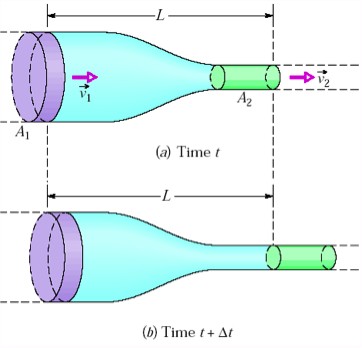Course Content I > Energy: The Quantity of Motion >Energy in fluid flow
6.5.2.1
Prerequisites
|
In the Bernoulli's principle page, we derived the result of the work-energy theorem applied to an incompressible fluid flowing smoothly when we can ignore the effect of resistive forces (e.g., viscosity). The result is Bernoulli's principle:

|

|
These equations should look familiar: they strongly resemble a conservation of mechanical energy equation but divided by the object's volume and with the addition of a pressure term.
The ½ϱv2 term is the kinetic energy density (KE per unit volume), the ρgh term is the potential energy density (PE per unit volume) and it shows that the pressure resembles a potential energy density as well. There, the volume factor missing is an area (to convert P to a force) times a distance (the distance traveled to make a force into a work).
Let's consider two examples: one case where the height doesn't change, but the pipe narrows and one where the pipe is the same width -- but there is no flow at all!
Example 1: Narrowing pipe, fixed height
|
If the height doesn't change much, the gravitational PE term can be dropped and we get

This relation tells us how much the pressure has to drop when the speed of the fluid increases due to a narrowing of the pipe and answers the question we started with. It makes it clear that the pressure forces are what is responsible for the change in the fluid's speed and that there is a cost to pushing a fluid through a narrowing pipe even when we can ignore resistive forces! The pressure has to drop for the fluid to speed up.
|
 |
This is interesting — and a bit surprising. Did you expect a lower pressure or higher when the fluid moves faster?
Example 2: No flow, changing height
|
If the velocity doesn't change or even if it remains 0 (a static situation) then the velocity terms drop out of our Bernoulli principle and we get

The second form is just a rewrite of the equation describing how the pressure changes as you descend into a fluid: P = P0 + ρgd. (See Archimedes' Principle.) There, we used symbol "d" for depth to remind us that the pressure increases with depth. In the Bernoulli/Work-Energy theorem, we use the symbol "h" for height and the minus sign (from the dot product) so our gravitational PE comes out as increasing when we go up.
|
 |
It's interesting that we can see the dependence of the pressure in a fluid on depth (height) as a version of Bernoulli's principle! This isn't really a surprise, though. In our previous discussion we used forces. Here we describe it using energy. Energy and force can often be used to describe the same system often yielding complementary insights.
Joe Redish 7/21/17
Comments (0)
You don't have permission to comment on this page.